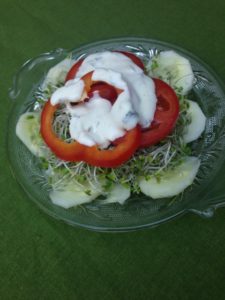 The importance of salad vegetables is currently being questioned as feeding the world population takes focus. A recent Washington Post article described lettuce as “leafy-green waste of resources”. Other researchers have criticized salad vegetables as “almost all water” and have to be transported in refrigerated trucks which increases their fossil fuel footprint.
The importance of salad vegetables is currently being questioned as feeding the world population takes focus. A recent Washington Post article described lettuce as “leafy-green waste of resources”. Other researchers have criticized salad vegetables as “almost all water” and have to be transported in refrigerated trucks which increases their fossil fuel footprint.
Yes, lettuce is known as the number one cause of foodborne illnesses by the Centers for Disease Control and Prevention- 22 percent of all food related illnesses in 1998-2008.
Salads can cause overindulgence for dieters who load them up with high fat dressings, croutons, cheese and bacon bits. But, salads offer nutritional benefits if all leafy greens are washed before consumption despite the triple washed declaration on the package. Homemade salad dressings can include healthy choices like celtic or Himalayan sea salt, cultured dairy products with active cultures, and fresh herbs.
Not everything that is on the local salad bar should be consumed raw according to Elizabeth Jefferey, Ph.D. at the University of Illinois-Urbana. Her laboratory focuses on biochemical and nutritional diet components. Cruciferous vegetables- broccoli, Brussels sprouts, kale, Swiss chard- offer better detoxification benefits if they are consumed lightly steamed. Heat penetration releases enzymes for helping the liver clear deleterious compounds that can be toxic to the body. Frozen broccoli does not offer any of those same benefits because blanching degrades the compounds needed to release sulforaphane and indole-3-carbinol that have been found important in cancer prevention.
Sprouts can be dangerous because of salmonella contamination but growing your own is easy. Hydoponically grown broccoli, radish and alfalfa sprouts offer nutrient benefits for a healthy salad and can be the base for the salad like the recipe below.
One cup serving comparison of salad greens can help you make healthy choices. One of the major reasons for consuming raw salad greens is for the fiber content which is not taken into consideration when growers say that soli should be used for potatoes or corn instead.
Romaine lettuce: 76 mg Folate, 14 mg Vitamin C, 1456 IU Vitamin A
Red Leaf Lettuce: 28 mg Folate, 10 mg Vitamin C, 1064 IU Vitamin A
Iceberg Lettuce: 31 mg Folate, 2 mg Vitamin C, 182 IU Vitamin A
Radicchio: 24 mg Folate, 3 mg Vitamin C, 111 IU Vitamin A
Arugula: 19.4 mg Folate, 4 mg Vitamin C, 474 IU Vitamin A
Alfalfa Sprouts: 11.9 mg Folate, 3 mg Vitamin C, 51 IU Vitamin A
Radish Seed Sprouts: 36.1 mg Folate, 11 mg Vitamin C, 149 IU Vitamin A
For a healthy salad, lightly steam your cruciferous vegetables before adding them to your salad greens and garnish with slices of radish and tomatoes. Cooking tomatoes increases the lycopene benefits. Since lycopene in tomatoes and Vitamin A benefits from salad greens are lipid soluble, fat is important in your salad dressing.
Broccoli Sprouts Salad & Buttermilk Ranch Dressing
1 cup fresh broccoli sprouts
1/4 cup thin cucumber slices
1 plum tomato, sliced
Red pepper slice
2 tablespoons Buttermilk Ranch Dressing
Arrange sprouts, cucumbers and tomato slices on plate. Top with red pepper before drizzling on dressing. Makes 1 serving.
Buttermilk Ranch Dressing
1/2 cup buttermilk or kefir
1/2 cup plain whole milk yogurt
1/4 cup mayonnaise
1 clove garlic, minced
1 teaspoon sea salt
2 scallions, chopped fine
1/4 cup chopped fresh basil or dill
Combine all ingredients in bowl. Whisk until blended. Chill until ready to serve.
Calories per 2 tablespoons 67
Protein 1g
Carbohydrates 1g
Fat 5g
Sodium 182 mg